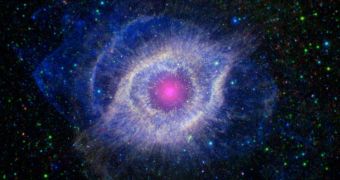A team of astronomers at the American space agency recently combined data from two space telescopes to produce one of the most amazing images ever captured of the renowned Helix Nebula.
The cosmic structure is located around 650 light-years away from Earth, in the constellation of Aquarius, and is known among astronomers as NGC 7293. Officially, it is cataloged as a planetary nebula. The name was given by early astronomers, whose telescopes saw these nebula as gas giants.
In order to capture this image, experts used infrared data from the NASA Spitzer Space Telescope, which is operated by the NASA Jet Propulsion Laboratory (JPL), and the Galaxy Evolution Explorer (GALEX), which is currently operated by the California Institute of Technology (Caltech).
The progenitor star for this nebula is currently dying, astronomers say. As a result, it is shedding the outer layers of its atmosphere, producing a dusty shell that is heavily radiated, at ultraviolet wavelengths, by the enduring, hot stellar core.
The latter is known as a white dwarf. Its current state will be reached by the Sun as well, in about 5 billion years or so. White dwarfs are the cores of former stars that have exhausted their hydrogen fuel supplies, and have switched to burning helium.
The element is a byproduct of nuclear fusion. The hydrogen isotopes deuterium and tritium fuse at the cores of stars to create helium and vast amounts of energy. When a star around the size of the Sun dies, it switches from one fuel to the other, and can endure as a white dwarf for more than 3 billion years.
Our own parent star will produce a planetary nebula when it reaches the end of its main sequence. It will begin to burn helium, and convert it into heavier elements, including nitrogen, carbon and oxygen.
“Eventually, the helium will also be exhausted, and the star dies, puffing off its outer gaseous layers and leaving behind the tiny, hot, dense core [… which] is about the size of Earth, but has a mass very close to that of the original star; in fact, a teaspoon of [material] would weigh as much as a few elephants!” NASA reports.
The background of this image was collected by the NASA Wide-field Infrared Survey Explorer (WISE) spacecraft, which produced a map of the Universe at IR wavelengths. “The white dwarf star itself is a tiny white pinprick right at the center of the nebula,” NASA experts conclude.

 14 DAY TRIAL //
14 DAY TRIAL //